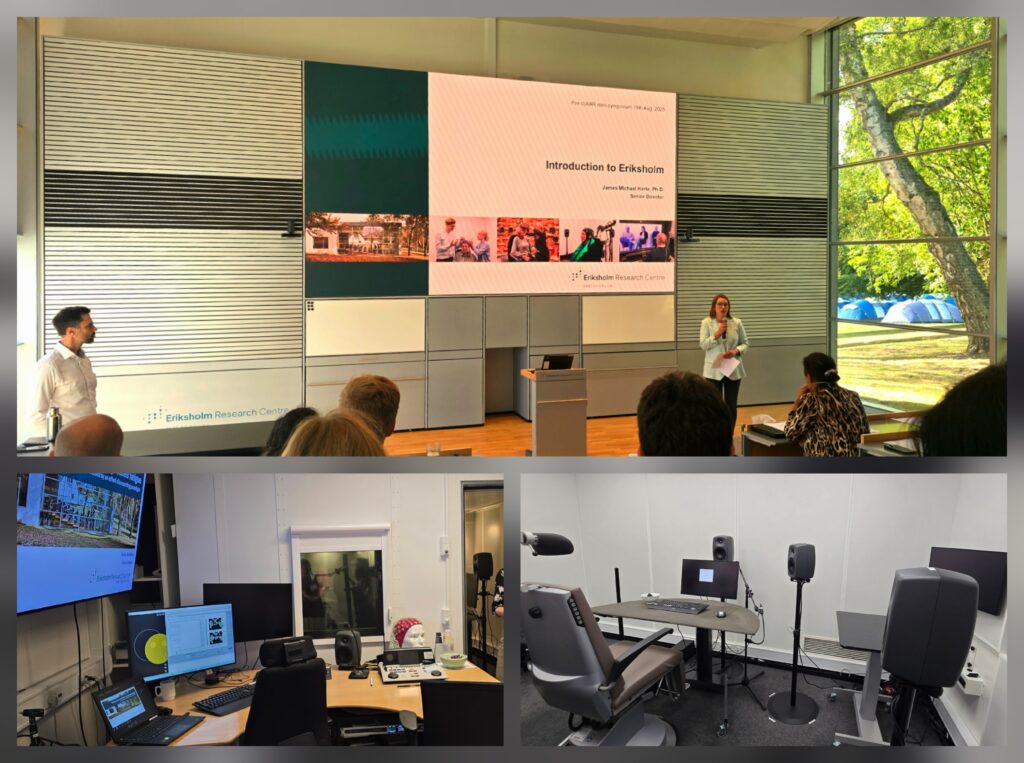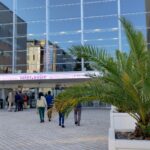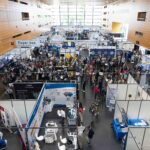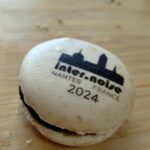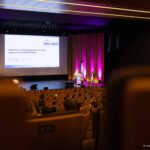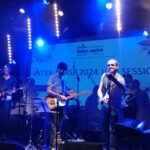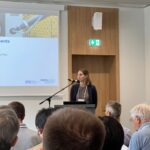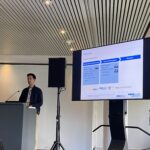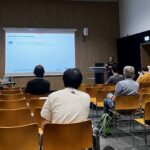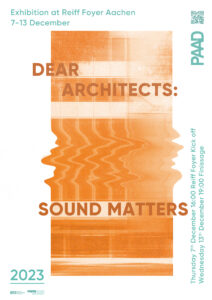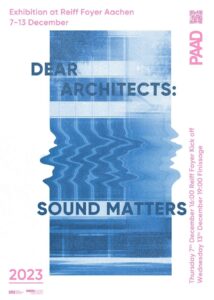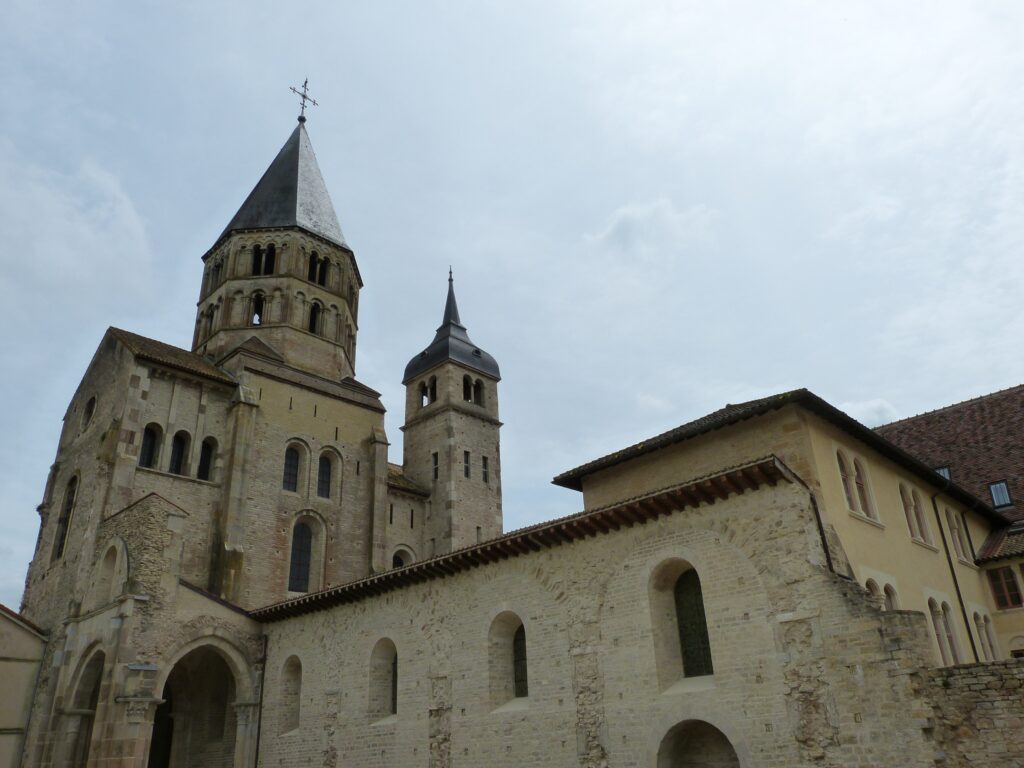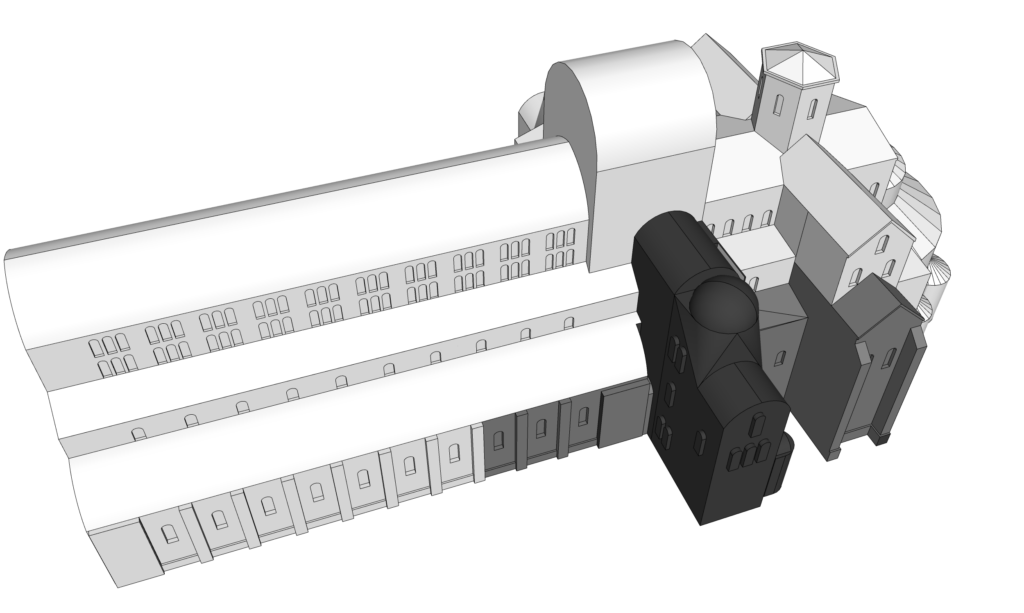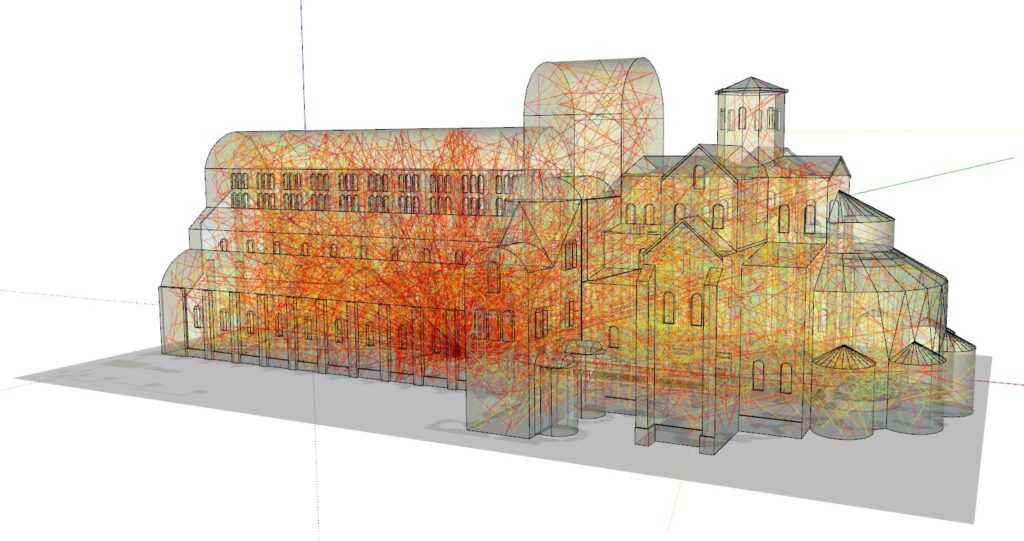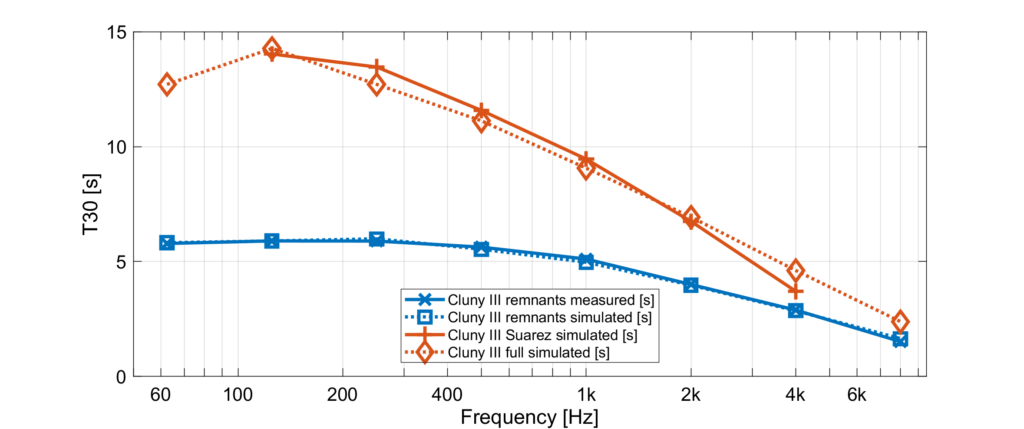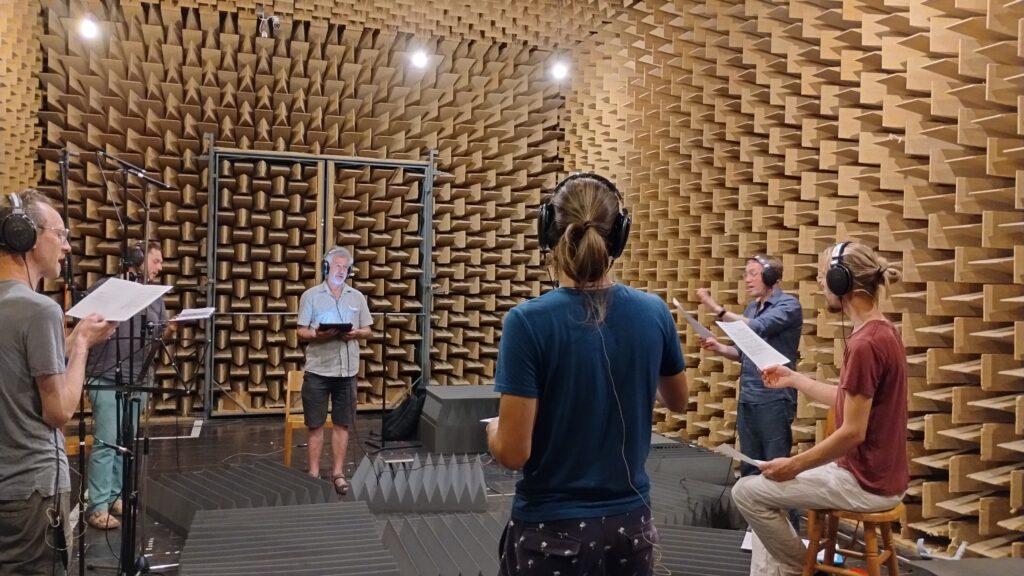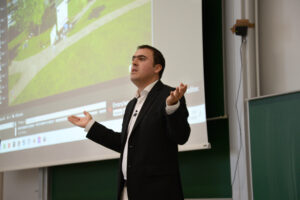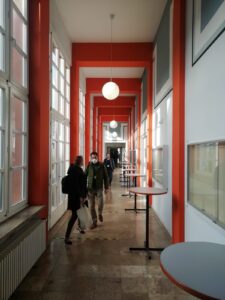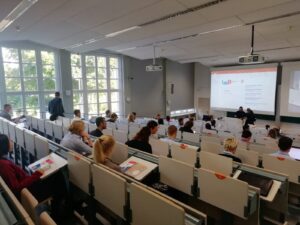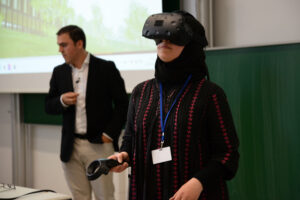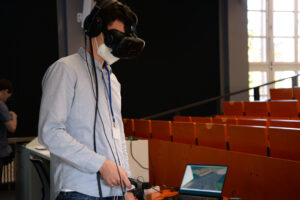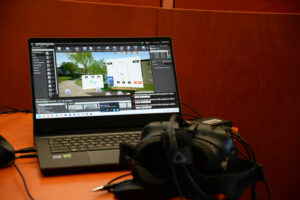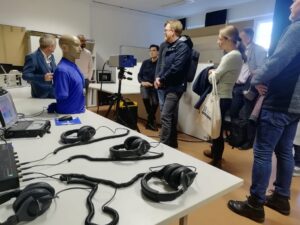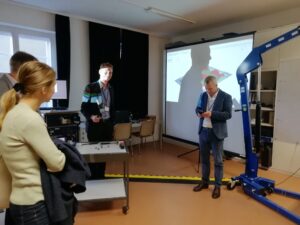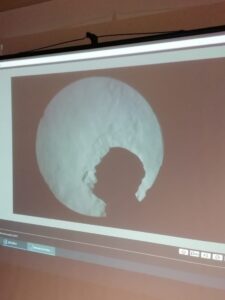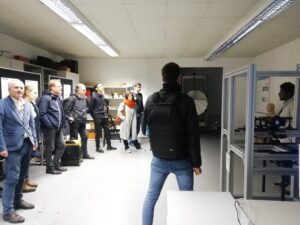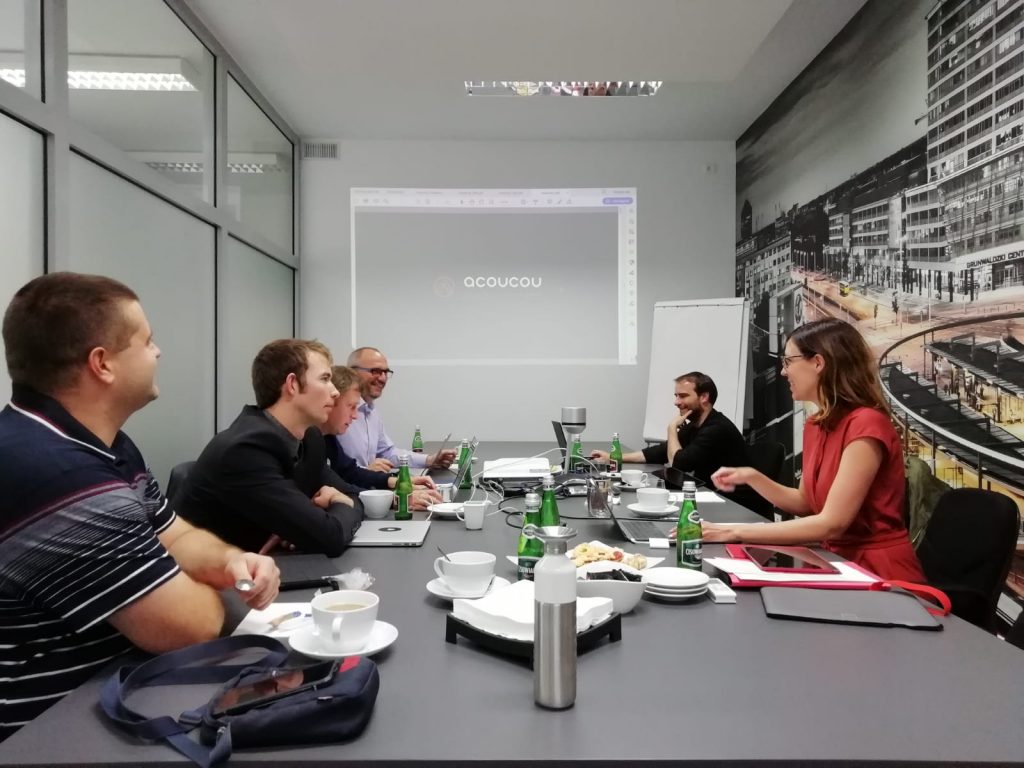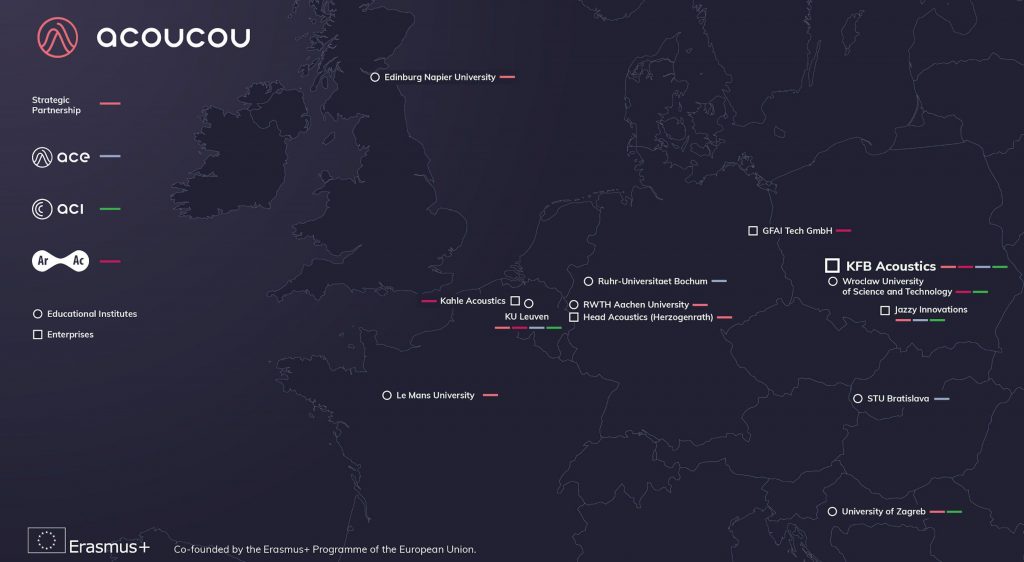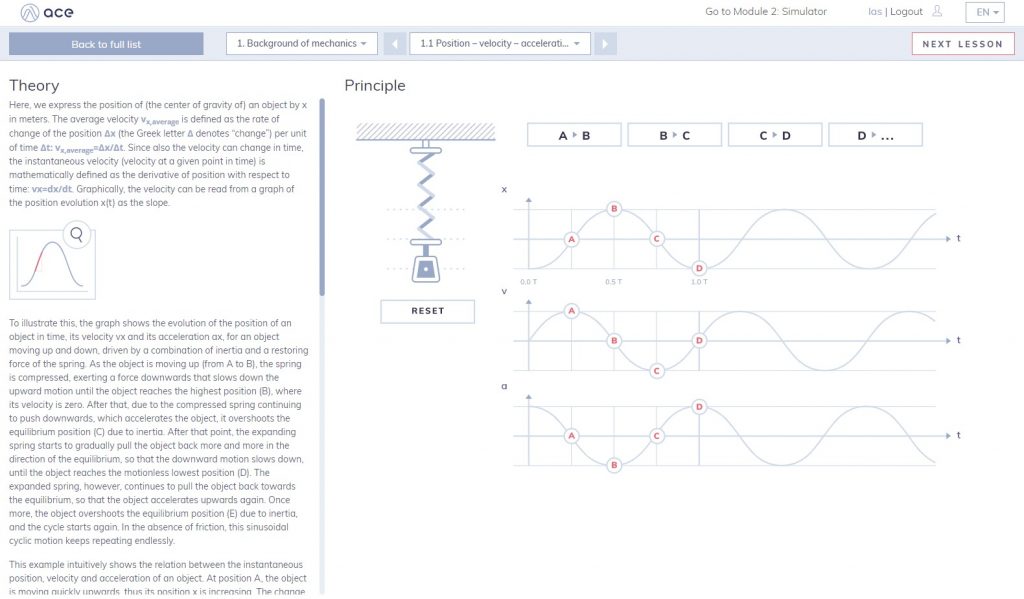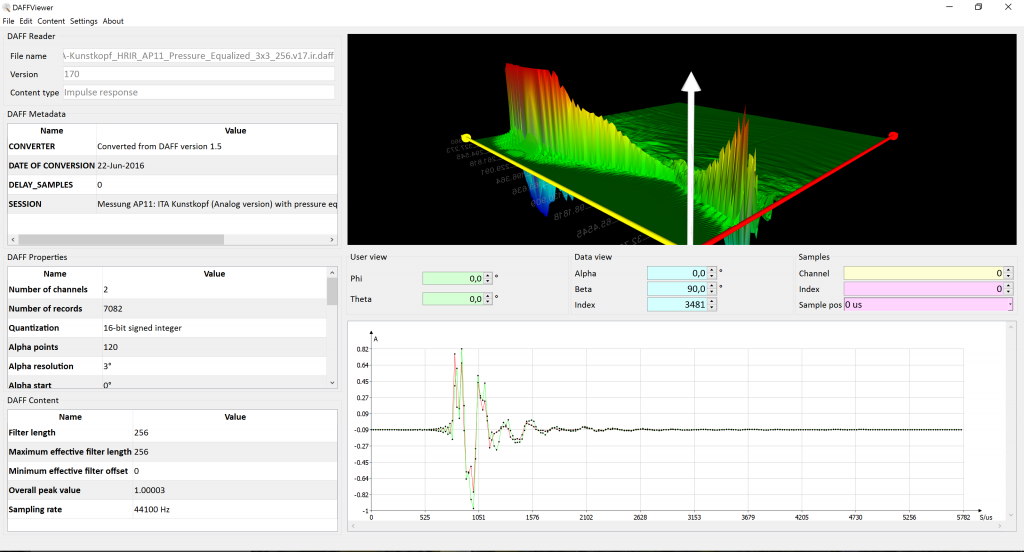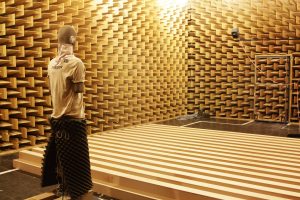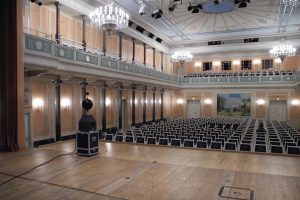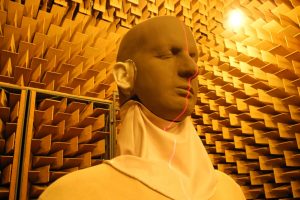Kategorie: ‘Virtual Acoustics’
Janina Fels und Cosima Ermert beim „International Symposium on Auditory and Audiological Research – ISAAR 2025“
Vom 19. bis 22. August 2025 reisten Janina Fels und Cosima Ermert nach Dänemark, um das „International Symposium on Auditory and Audiological Research – ISAAR 2025“ in Nyborg zu besuchen.
Janina Fels hielt einen eingeladenen Vortrag zum Thema „Exploring Auditory Cognition: Connecting Real-World Contexts with Interactive Virtual Environments” und stellte dabei mehrere laufende Forschungsvorhaben vor, die sich speziell mit selektiver auditiver Aufmerksamkeit und Höranstrengung (Listening Effort) bei Kindern in Klassenräumen unter realistischen Hörbedingungen befassen.
Cosima Antonia Ermert präsentierte dazu ein Poster mit dem Titel „Listening Effort in Populated Audiovisual Scenes Under Plausible Room Acoustic Conditions”.
Einen Tag vor der ISAAR reiste Janina Fels zum „Pre-ISAAR Mini-Symposium“ beim Eriksholm Research Centre. Sie hatte die Gelegenheit, mehr über aktuelle Themen und Projekte zu erfahren und diese ausführlich zu diskutieren. Es fand eine exzellente Führung durch die Labore statt und es wurden zahlreiche hochinteressante Posterpräsentationen abgehalten. Zudem wurden eine Vielzahl neuer Ideen für zukünftige Kooperationen diskutiert.
Währenddessen nahm Cosima Ermert am „Workshop in Communication in Hearing Science” von WS Audiology teil. Dieser Workshop beschäftigte sich mit dem Thema „Understanding how noise and hearing impairment affect communication”. Cosima präsentierte für das IHTA ein Poster mit dem Titel „Bringing real-life into the lab: Investigating speech in virtual auditory environments – which aspects contribute to a plausible simulated conversational situation?”.
Virtual Acoustics: Release Version 2024a
The newest version of our auralization framework Virtual Acoustics (VA) was just released. The new version comes with a reworked python interface (VAPython) which is more user-friendly and now has *NatNetTracking* support. Also, there are some minor improvements in the audio rendering process.
The current as well as all former releases are now hosted on Zenodo, which allows citing a specific VA version without any ambigouity.
Further information on VA can be found on the project’s website. This includes a detailed changelog.

Inter-Noise 2024 in Nantes
This year’s Inter-noise conference took place from August 25th to 29th in Nantes, France. More than 1500 delegates participated in this conference and presented interesting research in the field of acoustics and noise. Highlights of the conference included a plenary talk by Arnaud Can and Pierre Aumond (Joint Research Unit in Environmental Acoustics at Gustave Eiffel University, Nantes, France) on advanced characterization of urban sound environments and a keynote lecture about the child perspective on noise exposure and health effects, held by Kerstin Persson Waye from Gothenburg University, Sweden, who is also collaborating with IHTA in the Equal-Life project.
Members of IHTA travelled to the conference and presented the following research papers:
- Chalotorn Möhlmann: Validation measurement of vehicle pass-by models for dynamic urban environments (results of the BaLSaM project)
- Marco Berzborn: Inference of the acoustic properties of transversely isotropic porous materials
- Lara Stürenburg: Loudness and preference judgments for noises of a heat pump (results of the LowNoise project)
- Joao Fatela (Guest researcher from the University of Campania Luigi Vanvitelli, Naples, Italy):
An experimental setup to investigate relevant validation parameters for the auralization of commercial aircraft flyovers in complex urban contexts
Directly after the closing ceremony of the conference, the satellite workshop “Unlocking the Potential of Open Research Software in Acoustics at Inter-Noise 2024” started. This event was organized by Maarten Hornikx and Huiqing Wang, from the Building Acoustics team of Eindhoven University of Technology, and included interesting exchanges and presentation on the development, maintenance, documentation and distrubtion of acoustics-related open-source software. As one of four invited speakers, Lukas Aspöck held a presentation about IHTA’s auralization software Virtual Acoustics. The slides of this presentation are available for download (CC BY-SA 4.0).
Next to insightful overview presentations by Maarten Hornikx and Huiqing Wang, further successful research software was presented: Pyroomacoustics by Eric Bezzam, NoiseModelling by Pierre Aumond and SoundScapy by Andrew Mitchell, along with many examples of challanges and best practices for open research and open-source software development. Many thanks to Maarten and his team for the invitation and the organization of this exciting event.
- Entrance of the InterNoise venue. Photo: Lukas Aspöck
- Exhibition area at Internoise. Photo: Simon Bianchetti.
- Internoise 2024 Macarons. Photo: Lukas Aspöck
- Kerstin Persson Waye at her keynote presentation. Photo: Simon Bianchetti.
- Jam Session @ InterNoise. Photo: Lukas Aspöck
- Lara during her presentation. Photo: Lara Stürenburg.
- Chalotorn during his presentation. Photo: Carolin Schliephake.
- Lukas during the research software workshop. Photo: Enkela Alimadhi
New exhibition DEAR ARCHITECTS: SOUND MATTERS
How often do you think about sound? How do you want people to feel when you are designing a space? Good acoustics design is inherent to architecture. Every decision you make about shape, form, geometry, volume and materials defines the acoustics. So how do you design proactively for the right outcomes, the first time?
With the comprehensive exhibition DEAR ARCHITECTS: SOUND MATTERS we want to link the field of acoustics more with that of architects. We show how acoustics are integrated into the design process and how auralization and simulation tools make it possible to experience acoustics at an early stage.
The exhibition is organized by the PAAD group in collaboration with the Design Computation chair at the RWTH.
Place: Reiff Foyer of the Faculty of Architecture, RWTH Aachen University, Schinkelstraße 1, 52062 Aachen
Dates: 7-13 December
Finissage: 13th December at 19h
Contact person: Josep Llorca-Bofí, josep.llorca@akustik.rwth-aachen.de
New VA Release: Version 2023a
Sacred Sound: The acoustic reconstruction of no longer existing spaces
The project Sacred Sound – Sacred Space, led by musicologist Prof. Stefan Morent of the University of Tübingen, deals with the acoustics of sacred spaces as they existed and were used many centuries ago. In cooperation with IHTA, this project uses simulations to reconstruct, for example, the acoustics of the abbey church of Cluny III in order to auralize the liturgical chants of the medieval monks. Cluny III existed between 1130 and 1790 and was the largest church in the world until the construction of St. Peter’s Basilica in Rome.
Based on the room acoustic simulations, medieval choir chants were performed and recorded in IHTA’s laboratories by the ensemble Ordo Virtutum. During the recordings, the singers were presented with the reflections of the virtually reconstructed church space in real time. In further steps of the project these recordings will be analyzed musicologically in order to investigate the influence of the architecture on the musical performance.
Parts of the project were recently documented by the SWR in a radio (116 min.) and a TV report (20 min; both in German language).
- Remnants of Cluny III (Foto: CC0, pxhere.com)
- 3d model of cluny III. Black and dark grey parts show the still existing remnants of the church (Picture: Lukas Aspöck, CC-BY 4.0)
- Ray Tracing simulation in the acoustic 3d model of Cluny III (Picture: Lukas Aspöck, CC-BY 4.0).
- Simulated (and measured) reverberation times for the remnants and the full church (Picture: Lukas Aspöck, CC-BY 4.0).
- Ensemble Ordo Virtutum during the recording session at the hemi anechoic chamber at the Institute (Picture: Lukas Aspöck, CC-BY 4.0).
Thanks for everyone at IHTA who supported this project. Thanks also to the Visual Computing Institute for helping out with the aixCAVE system and to the company Sennheiser for providing microphones for the recording sessions!
IHTA at the BauSIM conference in Weimar
From the 20th to the 22nd September 2022, the BauSIM conference took place. The scientific core topic of the conference is traditionally the energetic simulation in the building sector and offers an ideal discussion forum for experts from science and industry for mutual exchange. The conference is organized by the and IBSPA Germany-Austria, member of the International Building and Performance Simulation Association (IBPSA) This year’s conference introduced a new session on acoustic simulation topics, and our institute was present.
In particular, our Junior Principal Investigator Dr. Josep Llorca-Bofí, from the PAAD group was invited as key-note speaker, talking about The city – A machine for noise? Virtual acoustics in architectural design research. Together with our PhD student M. Sc. Jonas Heck and Professor Michael Vorländer, the following research paper was presented: 3D photogrammetry for auralization – An approach for geometry simplification and material categorization.
- Key-note talk Dr. Josep Llorca-Bofí
- Bauhaus-Universtät Weimar
- BauSIM lecture hall
- IHTApark demonstrator
- Immersive audio and visuals
- Portable research laboratory using head-mounted display and equalized headphones
- Visit to the acoustic laboratory at the chair of Building Physics
- Visit to the acoustic laboratory at the chair of Building Physics
- Optic visualization of thermal air movement
- Visit to the optics laboratory at the chair of Building Physics
Promotionsprüfung Muhammad Imran, M.Sc.
Am 4. Februar 2022 hat Herr Muhammad Imran seine mündliche Promotionsprüfung erfolgreich abgeschlossen.
Herr Muhammad Imran promovierte über das Thema:
„Virtual Building Acoustics – Auralization with contextual and Interactive Features“
Abstract:
Building acoustics auralization is used to assess the perceptual aspects of sound transmission in built environments to provide the guidelines for architectural constructions and to evaluate the noise effects on humans. These noise effects have a negative influence on daily-life activities and create disturbances in physical and metal work. These disturbances are present within the dwellings and/or might be from outdoor moving transient sound sources. Methods are available for auralization of sound insulation between connected rooms in compliance with the standardized data formats of sound insulation metrics and building structural geometries. However, there still exist certain challenges to be addressed to construct the transfer functions between noise sources and receiver room for indoor situations as well as for the outdoor moving sound sources and to make these sources audible through audio-visual virtual reality systems in real time and interactively. These challenges are due to certain simplifications which are implicit in the formulation on which the sound insulation prediction models are based, such as, diffuse field assumptions, neglecting source characteristics, and source and receiver room acoustics.
This thesis focuses on addressing the present challenges in the traditional sound insulation rendering techniques and establishing an interface between psychoacoustic research and building acoustics in dwellings (especially airborne sound insulation) integrated with audio-visual virtual reality environments. From the technical perspective, improvements are made in sound insulation prediction methods, and corresponding filter construction and rendering techniques for auralization. In the first place, the building elements are considered as multitude of secondary sources rather than taking them as point source radiators and the bending wave patterns are addressed in order to be able to properly construct the transfer functions from source to the receiver room. Secondly, the room acoustical simulations are carried out for both source and receiving rooms to generate transfer functions from source to the source room walls and from radiating receiving room walls to the listener, so that the geometries and absorption might be fit to the properties desired by the user for the spatial impression of the listening rooms. In addition, the transfer functions from radiating walls of the receiving room to listener are designed in such a way that not only indoor sources are handled nevertheless the outdoor moving sources are also addressed.
Some important conditions are associated with virtual building acoustics auralization research platform for advanced studies of noise effects in dwellings which are addressed. The audio files, generally, used in listening tests are arbitrarily manipulated by audio samples without the background of a physical model of the built environments. They must comply with the standardized data formats of sound reduction indices (level differences) and/or sound transmission coefficients. Other data related to building structure such as geometry shall be strictly connected to the architectural design, the building materials and constructions. Otherwise the conclusions of the psychoacoustic experiments have no direct correlation with the architectural design, especially when presented through virtual environments. To achieve this, the auralization framework is extended toward real-time interactive audio-visual technology, i.e. VR technology, in order to be able to introduce more realism and, hence, contextual features into psychoacoustic experiments. The building acoustics framework is validated by taking indoor and outdoor example case studies. Listening experiments close to real-life situations are carried out by using this framework to show that this framework can be used as an alternate to design new test paradigms which help to better analyse and interpret the noise impact in building situations depending on the actual activity such as working, learning, and rest.
Das IHTA gratuliert sehr herzlich!!
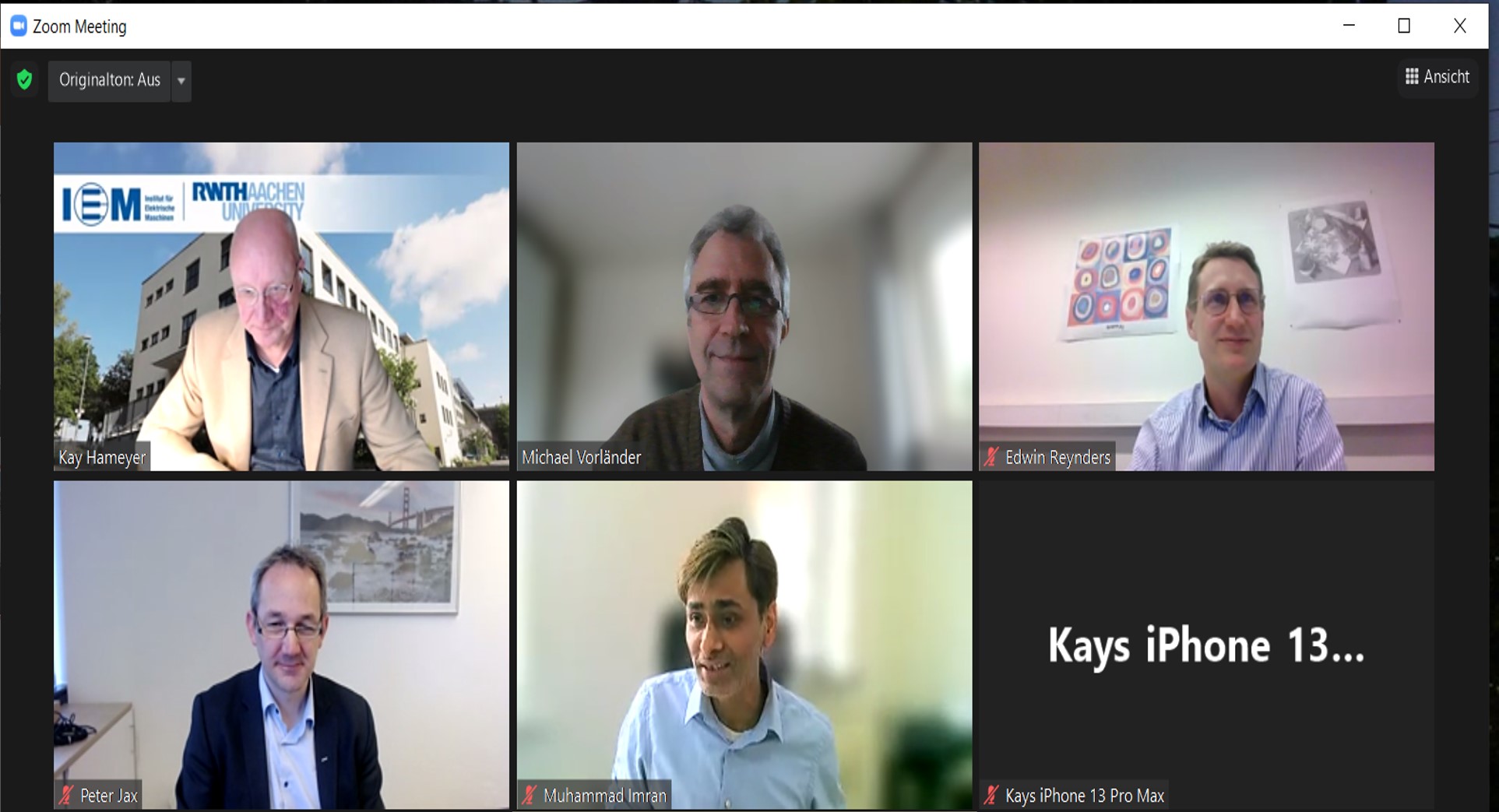
Doctoral exam Muhammad Imran, Examination committee: Prof. Dr. Kay Hameyer, Prof. Dr. Michael Vorländer, Prof. Dr. Edwin Reynders, Prof. Dr. Peter Jax
Promotionsprüfung Dipl.-Ing. Lukas Aspöck
Am 10. Juli 2020 hat Herr Lukas Aspöck seine mündliche Promotionsprüfung erfolgreich abgeschlossen.
Herr Aspöck promovierte über das Thema:
„Validation of room acoustic simulation models“
Abstract:
Already in ancient times, the goal existed to design appropriate environments to transport acoustic signals from a sound source to an audience. Strongly connected to this is the interest to understand room acoustic effects and, in the best case, to accurately predict them. This is of particular relevance today in prestigious projects such as the construction of concert halls, but is also of great importance in everyday life, for example in public buildings. Room acoustic simulations based on the concepts of geometric acoustics have been developed for such purposes for more than 50 years and have been extensively investigated. However, there is still insufficient knowledge about the uncertainty and validity of the results of the room acoustic simulations used today. In addition, many highly simplified simulation models are often used without questioning the validity of the results.
In order to offer developers and researchers a possibility to comprehensively validate the results of their room acoustic simulation, a database with eleven different acoustic scenes was developed, documented and published. The scenes cover both simple environments, where individual acoustic effects such as reflection or diffraction are isolated, and complex spatial situations such as a concert hall. In addition to a detailed description and the definition of input data, acoustic measurements were carried out for all scenes, which serve as reference for the simulations.
Furthermore, a study is presented which was designed following the concept of three previously conducted round robin experiments. Here, the simulation results of up to six participants, who were not informed about measurement results in advance, are compared with each other and with the results of the corresponding measurements. The evaluation of the results for the simple scenes reveals various weaknesses of the geometric acoustics, but in the case of the complex scenes it nonetheless shows acceptable results in the medium frequency range. In further investigations it was determined how much room acoustic simulation results deviate from measurements if the user knows the measurement results beforehand and input data of the simulation is adjusted manually or systematically. From these results it can be concluded which deviations from actual, measured values can be expected in the room acoustic simulation of both unknown and known rooms. Furthermore, this work provides a basis for improvements in the field of geometrical acoustics simulation models and with respect to the determination and selection of correct input data for the simulation.
Das ITA gratuliert sehr herzlich!!
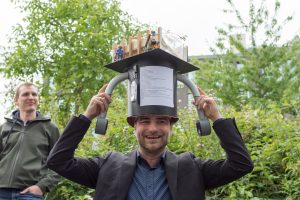
ACOUCOU: Development of web-based teaching materials for acoustics
More than one year ago, the polish company KFB Acoustics initiated a Strategic Partnership involving four European universities (KU Leuven, University of Le Mans, University of Zagreb and RWTH Aachen University) and two companies (HEAD Acoustics and KFB Acoustics), funded by the Erasmus+ program of the EU, with the goal to develop ideas and concepts for the implementation and extension of an online teaching portal including various courses on acoustics. This portal, called ACOUCOU, short for Acoustic Courseware, is available on www.acoucou.org and currently contains one course about Vibroacoustics and example materials from the previous project Acoustics for Industry (ACI).
At the end of October, two ITA employees participated in the final meeting in Wroclaw, Poland, where the outcomes of the project and future events related to the ACOUCOU platform were discussed. The most recent event, an interactive session on educational materials in acoustics, which took place at the ICA conference in Aachen, was rated as a great success by all participants and led to new contacts and helped to disseminate the teaching portal.
The project consortium is also happy to announce that additional funding was granted by the EU to fill the teaching portal with more course contents in a three-year project starting in 2020. This project is named Acoustics Knowledge Alliance (ASKNOW) and is part of the Erasmus+ Knowledge Alliance program.

Final meeting in Wrocław, Poland
(Photo: Karolina Jaruszewska)
Final meeting in Wrocław, Poland (Photo: ITA) 
Overview of project partners 
Example of web-based teaching material from the course Acoustics for Engineers (ACE)
Follow updates of the ACOUCOU initiative on social media channels: Facebook – Twitter – Instagram
12. DEGA-Symposium „Interdisciplinary Topics in Acoustics“
Many thanks to all who took part in the symposium on „Interdisciplinary Topics in Acoustics: Physiology and Virtual Reality“ in Aachen.
It was an interesting and horizon-opening conference.
You can download the final program here:
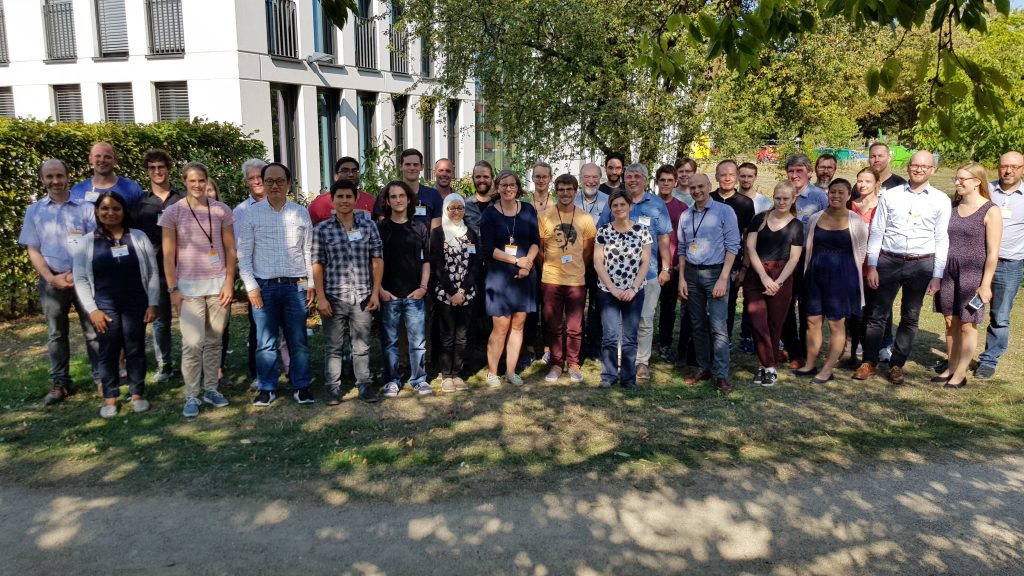
Summary:
The 12 DEGA symposium with the title ”Interdisciplinary topics in Acoustics: Physiology and virtual reality” has the goal to connect researchers and scientists working in the fields of physiological and virtual acoustics. These two fields have both, a high relevance for society and a huge potential for application and innovation, supported by increasing rate of technological development. A basic understanding of the physiological basis of sound processing is not only required to develop novel technologies, but also required to tackle the increasing challenge of hearing impairment in our society.
New developments in the field of virtual acoustics allow, besides novel applications in audio industry, to generate and control complex sound fields with high precision required in scientific experiments. These two fields together bear the potential to make large progress in the understanding of signal processing in the auditory system of humans, way beyond classical approaches.
The program is organized by the technical committee of Hearing Acoustics of DEGA.
Coordination: Janina Fels and Bastian Epp
Virtual Acoustics project launch
The Virtual Acoustics (VA) open source project has been launched and the official website can be accessed via
http://www.virtualacoustics.org
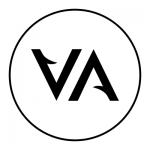
The website provides an overview of VA and documentation on interfaces and usage. In the download section, a ready-to-use VA preview package for Windows can be obtained. The entire project is open source and can be used for reproducible research.
OpenDAFF v17 released
A new stable version of OpenDAFF (v17) has been released. A Windows package is available for 64-Bit platforms that includes the DAFF libraries as well as the DAFFViewer application to inspect DAFF content. Also, more and more HRTF datasets are becoming available, especially because you can now convert SOFA files into DAFF content using the ITA-Toolbox and it’s itaHRTF class.
Read on about OpenDAFF at www.opendaff.org!
Acoustic Virtual Reality movies online
On the Acoustic Virtual Reality website three movies have been added that were shown several times at different conferences.
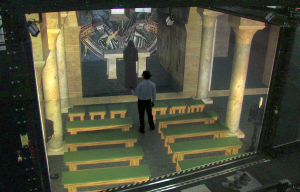
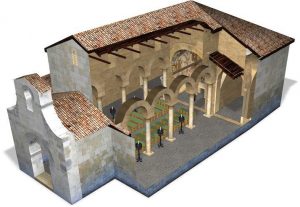
(Copyright ITA)
ITA stellt Boost Projekt zu „Experiments on the perception of complex listening scenarios of children with hearing loss complemented by fNIRS measurements“ auf RWTHtransparent vor
Am 27.01.2017 stellte das ITA das BOOST Projekt „Experiments on the perception of complex listening scenarios of children with hearing loss complemented by fNIRS measurements“ auf RWTHtransparent vor.
Das Projekt unter der Leitung von Univ.-Prof. Dr.-Ing. Janina Fels ist ein interdisziplinäres Forschungsprojekt gefördert vom Exploratory Research Space unter Beteiligung der Uniklinik der RWTH Aachen in Zusammenarbeit mit Univ.-Prof. Dr. rer. nat. Kerstin Konrad, Univ.-Prof. Dr. med. Christiane Neuschaefer-Rube und Univ.-Prof. Dr. rer. nat. Michael Vorländer.
[huge_it_gallery id=“5″]
Distinguished Lecture at CIRMMT McGill University by Michael Vorländer
CIRMMT has published a talk on the topic Virtual musical Instruments in virtual rooms – what’s real at all? by Michael Vorländer on YouTube.com.
More information: http://www.cirmmt.org/activities/distinguished-lectures/vorlander
Web-based VR tool for online audio-visual studies
The members of the SONORUS (Urban Sound Planner) project have published an interesting approach to conduct audio-visual studies using Unity and a conventional web browser. Fanyu Meng did some supporting work for procedural sound synthesis. For more information and the link to participate, see here:
Web-based virtual reality tool for evaluation of urban sound environment
SEACEN International Round Robin on Auralization
Researchers of the SEACEN project have officially launched the 1st International Round Robin on Auralization. In this extensive comparison of simulation and auralization tools, researchers, users and developers can contribute their results for nine different acoustical scenes including a variation of simple acoustical situations as well as typical room acoustical scenarios. Everyone is invited to particpate. In the first phase of the Round Robin, participants are ask only to use the provided input data. Deadline for the submission of the results is december 31st, 2016.
- Simple reflection scene
- Room acoustics measurement Berlin chamber music hall
- Measurement of binaural impulse responses using FABIAN dummy head
More information can be found on the offical Auralization Round Robin website.
OpenDAFF license change
Good news, everyone! OpenDAFF has changed the license from the GNU Lesser Public License to the Apache License Version 2.0. This means, that the copyleft has been dropped making it more easy to use the OpenDAFF C++ library within commercial products.
OpenDAFF new website online
The OpenDAFF project website has been updated.





